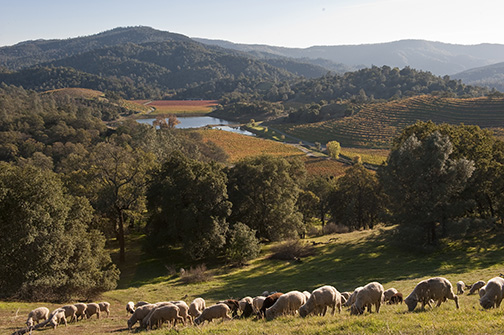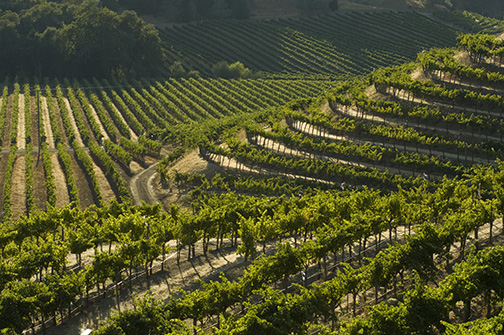
In 2004, Allan Chapman purchased the 1,615 acre Somerston property. He hired Craig Becker as general manager and winemaker to establish the winery and to build a brand from scratch.
We talk to Craig Becker about the entreprenuerial challenges he faced in establishing Priest Ranch and Somerston Estate.
Christopher Barnes: Craig, tell us a little bit about the estate that you started.

Craig Becker: In 2004, Allan Chapman bought the Priest Ranch, and it's just a little over 600 acres. It's in the eastern hills of Napa Valley, about 20 minutes due east of Rutherford. The following year, we had the chance to buy the neighboring 990 acres and combine these two properties that were not together at one time into a new estate called Somerston Estate.
How many acres total do you have?
1615 acres.
That is a lot of land.
It's a big property with 215 acres of vineyard.
Tell us a little bit about the concept behind Priest Ranch. I mean, what are you striving for with the property and with the wines?
We're really showcasing what brought Napa its fame and international notoriety. It's focused on the land, this amazing place. The soil, the climate, the people combine to really build, I think, legendary wines, specifically Bordeaux varieties. So in the end, with Priest Ranch, we're building a brand that we want consumers to trust because it comes from a place that's known. It's our land, and as we grow and produce more wine, we want customers to realize that this is from the same place and really believe in the quality that we're delivering.
How do you build a brand from scratch? I mean, there's like ... You walk into a wine store and you see the California category, and it's like how do you get onto those shelves? How do you build something in a very competitive marketplace?
It's tough. It's expensive. It's challenging, for sure, but you've got to attack it on all fronts. You've got to tell your story. It's got to be compelling. People have to want to listen. You've got to make really good wine. That's sort of a given, and then you've got to have good PR, good stories, good angles. You've got to get good reviews. You've got to make a lot of friends. It's really a beachfront on many beaches, and it takes time. They say it takes about 10 years to build a brand, a wine brand. And we're about halfway through that.
So perseverance, a lot of nights away from home, and making new friends, like yourself.
Tell us a little bit about your philosophy of wine-making. What are you striving for as a wine maker with this project?

Because we're talking about a place, and Priest Ranch wines come from all over this combined new property, made it multiple blocks. Somerston wines come from a single block, so we're showcasing two different elements of the property. We're trying to showcase this place and farming it to the point where the quality is maximized, the purpose is clear, and all the effort's done in the vineyard.
When it comes to the winery, you do what you're expected. You sort it. You pump it to the tank. You do all the typical wine-making stuff. You use native fermentation when you can and then age it in a balanced use of oak. So the heavy hand of the wine-maker is not so much present, more of the heavy hand of the property.
Do you have influences in your wine-making? Are there sort of regions or winemakers that influenced your style over the years?
Yes. The first winemaker I worked for, Craig MacLean, at Spring Mountain Vineyard, for sure. I worked at Mondavi. My first year there in '96, we did 17,000 tons of native fermentation so I wasn't afraid of native fermentations. So that's a style. It's a Y in the road. Some viticulturalists like Daniel Roberts. Obviously, David Ramey, I worked with him on a couple of projects. Guys who spend a lot of time working on their native techniques: hands off, focusing on the fruit, not so much their personality.
How long have you been making wine in Napa?
My first vintage was 1998. Before that, I was assistant winemaker, so that's like my 19th vintage coming up.
Wow. How has Napa changed over the years?
From my perspective, I kind of came in when the dot coms were invading, the first round of dot coms, and that's changed a little bit. There's a lot of brands out there that winemakers make their own wine. They work for a winery. There's just a lot more everybody's selling wine, a lot of it from the same source. Sauvignon Blanc is a good example of that. There's some vineyards in Yountville that 80% of the people get all their Sauvignon Blanc from.
So it's become more diversified, a little more confusing, a lot of more brand wines versus estates, but we're also seeing a resurgence of people buying land and producing just off that estate. Some of the older wineries are doing that. They're shifting back to controlling all their source. It takes a lot more money to get in the business now than when I first got in. Things are much more expensive. I mean, the average Napa Valley land sells for $250,000 an acre, and that's the average. That's your $20 bottle of wine.
Wow.
So not your $150 bottle of wine.

Tell us a little bit about the area that you're making your wine. What's the terroir like in the estate that you have right now?
We're in the eastern hills, so we get about half the rain that the western hills do, the Myacama Range, for the mountain rain effect, the mountain shadow effect, which means we're a little bit drier. There's oak woodlands, whereas Myacama has a lot of redwood and pine. So it's chaparral, it's oak woodland, and then old volcanic soil. So we've got eroded valley floors that have a lot of loam, and then we've got hillsides that are very similar to Akin soils that have about 70% rock. As you know, the more water soil holds, the more the vine's going to grow because real viticulture is the art of bonsai, trying to make that vine not realize it's a weed.
Tell us a little bit about the different types of wines that you're making right now at the estate.
The focus is Bordeaux varieties, Cabernet-based wines and Bordeaux blends. So we do Somerston Cab. We do a Merlot/Cabernet Franc called Stornoway, and that's typically about 75 to 80% Merlot, mountain Merlot, mountain Cabernet Franc. Then we do Priest Ranch Cab, and we do a wine called Coachgun, which dates back to the stagecoach era where there was the first sawed-off shotgun, and thus the term sitting shotgun. You were sitting next to a coach gun. That's a left bank Bordeaux blend. The vintage in market now is 75% Cab, 12.5% each of Petite Verdot and Merlot. Then we do some fun wines like Grenache Blanc and our Priest Ranch and Petite Sirah.
Read David White's column profiling Craig Becker and Priest Ranch.














